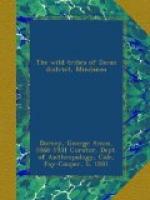[1] They are often referred to as Caragas in the early writings.
[2] Further information regarding these spirits will be found in the Relations of Loarca, 1582 (BLAIR and ROBERTSON, Vol. V, p. 171), and the Relation of Juan de Plasencia, 1589 (ibid, Vol. VII, pp. 189-96, Vol. XII, p. 265). It is worthy of note that the Bagobo spirit Toglat, who is one of the pair responsible for marriages and births, is sometimes addressed as Maniladan.
THE TUNGUD MOVEMENT
In 1908 a religious movement known as tungud started among the Manobo[3] at the source of the Rio Libaganon. Soon it had spread over practically the whole southeastern portion of Mindanao, and finally reached the Mandaya of the Pacific Coast. According to Mr. J. M. Garvan, of the Philippine Bureau of Science, the movement was instigated by a Manobo named Mapakla. This man was taken ill, probably with cholera, and was left for dead by his kinsmen. Three days later he appeared among the terrified people and explained, that a powerful spirit named Magbabaya had entered his body and cured him. He further stated that the world was about to be destroyed and that only those persons who gave heed to his instructions would survive. These instructions bade all to cease planting and to kill their animals for, he said, “if they survive to the end they will eat you.” A religious house or shrine was to be built in every settlement, and was to be looked after by divinely appointed ministers. Those persons who were at first inclined to be skeptical as to the truth of the message, were soon convinced by seeing the Magbabaya enter the bodies of the ministers, causing them to perform new, frantic dances, interrupted only by trembling fits during which their eyes protruded and gave them the semblance of dead men.
[3] Not the Kulaman.
By the time the tungud had reached the Mayo district it had lost most of its striking features, but was still powerful enough to cause many of the Mandaya to kill their animals and hold religious dances. The coast Moro, who at that time were restless, took advantage of the movement to further a plan to drive American planters and Christianized natives from the district. The leading Mandaya were invited to the house of the Moro pandita[1] “to see the spirit Diwata.” During several nights the son of the pandita impersonated the spirit and appeared in the darkened room. Over his chest




